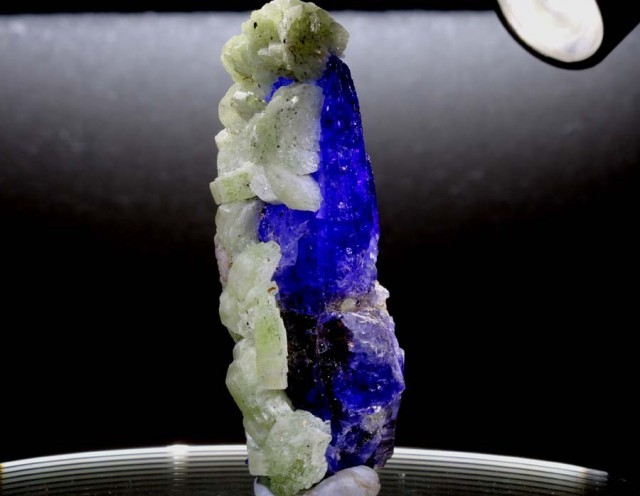CROCOITE AUSTRALIAN COLLECTOR SPECIMENT 166 CTS
- UGS
- spe
- Dimensions (mm)
- 46.000 x 43.000 x 22.000mm
- Poids (cts)
- 165.999
- Treatment
- No Treatment
- Taper
- Specimen
- Couleurs
-
CROCOITE -AUSTRALIA
SPECIMEN
BRIGHT HYACINTH -RED CRYSTAL ON MATRIX
TREATMENT-NONE
RARE COLLECTOR PC, NATURAL CLEAR CRYSTAL
WEIGHT : 166 CTS APPROX.
SIZE : 46 X 43 X 22MM APPROX
Crocoite is a mineral consisting of lead chromate, PbCrO4, and crystallizing in the monoclinic crystal system. It is sometimes used as a paint, being identical in composition with the artificial product chrome yellow. It was discovered at Berezovsky deposit near Ekaterinburg in the Urals in 1766; and named crocoise by F. S. Beudant in 1832, from the Greek κροκος, saffron, in allusion to its color, a name first altered to crocoisite and afterwards to crocoite. It is found as well-developed crystals, although these are usually poorly terminated. Crystals are of a bright hyacinth-red color, translucent, and have an adamantine to vitreous lustre. On exposure to light much of the translucency and brilliancy is lost. The streak is orange-yellow; Mohs hardness is 2.5–3; and the specific gravity is 6.0. In the Urals the crystals are found in quartz-veins traversing granite or gneiss. Other localities which have yielded good crystallized specimens are Congonhas do Campo near Ouro Preto in Brazil, Luzon in the Philippines, and Mutare in Mashonaland.
Gold is often found associated with this mineral. Exceptional examples of crocoite crystals have been found in the Adelaide Mine at Dundas, Tasmania; they are long slender prisms, 3 to 4 inches (7.5 to 10 cm) in length, with a brilliant lustre and color. Crocoite is also the official Tasmanian mineral emblem.
Associated with crocoite at Berezovsk are the similar minerals phoenicochroite and vauquelinite. The former is a basic lead chromate, Pb2CrO5, and the latter a lead and copper phosphate-chromate, Pb2CuCrO4PO4OH. Vauquelinite forms brown or green monoclinic crystals, and was named after L. N. Vauquelin, who in 1797 discovered (simultaneously with and independently of M. H. Klaproth) the element chromium in crocoite.
Relative rarity of crocoite is connected with specific conditions required for its formation: an oxidation zone of lead ore bed and presence of ultramafic rocks serving as the source of chromium (in chromite). Oxidation of Cr3+ into CrO42- (from chromite) and decomposition of galena (or other primary lead minerals) are required for crocoite formation.
- UGS
- spe
- Dimensions (mm)
- 46.000 x 43.000 x 22.000 mm
- Poids (cts)
- 165.999
- Treatment
- No Treatment
- Taper
- Specimen
- Couleurs
-
CROCOITE -AUSTRALIA
SPECIMEN
BRIGHT HYACINTH -RED CRYSTAL ON MATRIX
TREATMENT-NONE
RARE COLLECTOR PC, NATURAL CLEAR CRYSTAL
WEIGHT : 166 CTS APPROX.
SIZE : 46 X 43 X 22MM APPROX
Crocoite is a mineral consisting of lead chromate, PbCrO4, and crystallizing in the monoclinic crystal system. It is sometimes used as a paint, being identical in composition with the artificial product chrome yellow. It was discovered at Berezovsky deposit near Ekaterinburg in the Urals in 1766; and named crocoise by F. S. Beudant in 1832, from the Greek κροκος, saffron, in allusion to its color, a name first altered to crocoisite and afterwards to crocoite. It is found as well-developed crystals, although these are usually poorly terminated. Crystals are of a bright hyacinth-red color, translucent, and have an adamantine to vitreous lustre. On exposure to light much of the translucency and brilliancy is lost. The streak is orange-yellow; Mohs hardness is 2.5–3; and the specific gravity is 6.0. In the Urals the crystals are found in quartz-veins traversing granite or gneiss. Other localities which have yielded good crystallized specimens are Congonhas do Campo near Ouro Preto in Brazil, Luzon in the Philippines, and Mutare in Mashonaland.
Gold is often found associated with this mineral. Exceptional examples of crocoite crystals have been found in the Adelaide Mine at Dundas, Tasmania; they are long slender prisms, 3 to 4 inches (7.5 to 10 cm) in length, with a brilliant lustre and color. Crocoite is also the official Tasmanian mineral emblem.
Associated with crocoite at Berezovsk are the similar minerals phoenicochroite and vauquelinite. The former is a basic lead chromate, Pb2CrO5, and the latter a lead and copper phosphate-chromate, Pb2CuCrO4PO4OH. Vauquelinite forms brown or green monoclinic crystals, and was named after L. N. Vauquelin, who in 1797 discovered (simultaneously with and independently of M. H. Klaproth) the element chromium in crocoite.
Relative rarity of crocoite is connected with specific conditions required for its formation: an oxidation zone of lead ore bed and presence of ultramafic rocks serving as the source of chromium (in chromite). Oxidation of Cr3+ into CrO42- (from chromite) and decomposition of galena (or other primary lead minerals) are required for crocoite formation.
| Fournisseur d'expédition | Expédition vers Australia | Expédition dans le reste du monde |
|---|---|---|
| Standard Shipping - Tracked | $20.00 / 7 | $30.00 / 14 |
|
Australia
Standard Shipping - Tracked bénéficie d'une remise de $25.00 sur les commandes contenant 2 ou plus d'articles
Reste du monde
Standard Shipping - Tracked bénéficie d'une remise de $30.00 sur les commandes contenant 2 ou plus d'articles
|
||
| FedEx | $40.00 / 3 | $40.00 / 7 |
|
Australia
FedEx bénéficie d'une remise de $40.00 sur les commandes contenant 2 ou plus d'articles
Reste du monde
FedEx bénéficie d'une remise de $40.00 sur les commandes contenant 2 ou plus d'articles
|
||
| DHL | $30.00 / 2 | $30.00 / 21 |
|
Reste du monde
DHL bénéficie d'une remise de $30.00 sur les commandes contenant 2 ou plus d'articles
|
||

-
 Positif
PositifAmazing stone!
-
 Positif
PositifLove it!
-
 Positif
PositifVery pleased with the specimen and transaction
-
 Positif
PositifThis stone made me fall in love with Padparadsha sapphire. Truly wonderful!
-
 Positif
PositifSweet Thank you




















